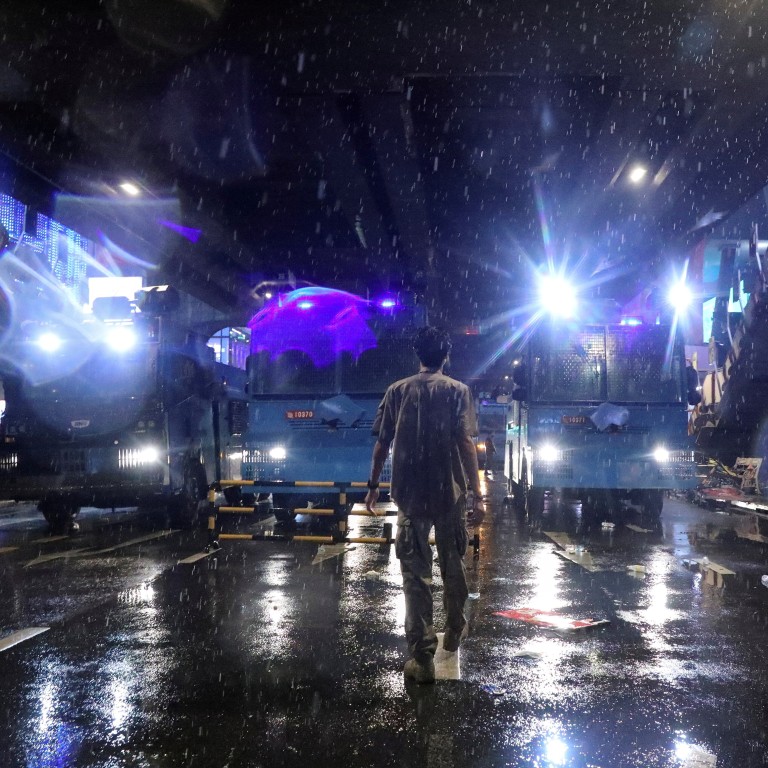
The problem with ‘Hunger Games’ photographs of the Thai protests
- The protests have given rise to a new style of documentary photography in which students are depicted as Hollywood heroines and Mockingjays
- But these deceptively beautiful pictures blur the line between art and reality, begging the question: did these events really occur?
Yet there has been little critical analysis of the photojournalism surrounding these events, which have drawn heavily on the iconography of The Hunger Games film trilogy.
The films portray a dystopian, post-apocalyptic future in which a three-finger salute represents solidarity among an oppressed population. The protagonist, Katniss, becomes the face of an uprising after winning a state-imposed battle royale. She is called the Mockingjay as a symbol of rebellion against the state’s dictatorship.
How Hong Kong and the Hunger Games inspired revolution of Thais
It’s a narrative that has been embraced on the streets of Thailand, where protesters have taken to raising their hands in the familiar three-finger salute. But this time it is to call for political reform and oppose the royalist military government.
Young Thai protesters such as Supitcha Chailom or Menu, a high school student, have been portrayed as Katniss-like heroines in carefully constructed images.
The Thai Enquirer, a news site, refers to Menu as a “political superstar”.
Menu does not seem out of place in Knot’s portfolio, a photographic sea of young, light-skinned women. She seems just another idyllic addition to his collection of portraits and lifestyle shots.
Apart from her impassioned speeches, little is known about Menu. But Knot’s photographs have transformed her into a poster girl for democracy, full of zeal, youth and beauty; an Instagram influencer mixed with gritty street reality.
But she has become something more, too, thanks to the narrative attached to the photo, which has spread through both social and traditional media. She has become a Mockingjay.
Explained: Why are there protests in Thailand and what will happen next?
To be fair, there is nothing wrong with idealised images of events. But there should be greater awareness and discussion of how these photos shape public perception and conversation about the protests.
While the pro-democracy movement is legitimate, these photographs present an emotional and even sentimental narrative of Thailand’s volatile circumstances.
These photographs, published on social media with little to no context, give too little emphasis to the motivations behind the protests.
Another example of how idealised images are dominating our understanding of the protests is in how different publications depicted the scenes in Bangkok on October 16. On that night the streets of Pathumwan were congested with defiant protesters and throngs of policemen carrying riot shields.
Khaosod, a daily newspaper, published softer, warmer photographs on Twitter while a photo of the same scene from wire agency Reuters had a cooler tone and grittier feel.
These fundamental differences confuse basic facts. Was the light from the streetlamps yellow or blue? What colour clothing were people wearing? Was it raining heavily or not?
I reached out to Pulitzer Prize-winning photographer Soe Zeya Tun from Reuters about his viral photograph of a man obstructing water cannon vehicles.
The Burmese photographer said: “To be honest, I don’t have a story behind the photo.
“I don’t know him or his intentions, but I don’t believe he was posing for a photo. It just happened in the moment, maybe even within a few seconds.”
So what actually happened? How did the man arrive or leave the scene, who was he, and what was the purpose of his actions?
The development of photography and editing has undoubtedly changed the way we document events today.
These changes are significant in evaluating the ethics of contemporary photojournalism. How do we determine the boundaries of what is ethical when producing images of protests?
Photojournalists should be impartial to narratives even in their artistic vision of an image. And with these artistic liberties should come the responsibility to be transparent about alterations to photographs.
Thai students are revolting – and the army-backed government isn’t sure what to do
Seeing these images and realising the manipulation of the protests’ narrative begs the question: did these events really occur? Or are they mere interpretations of photographs?
Photography has so much power that these images will change how we remember history.
While these images of the Thailand protests allow us to map out history as it happens, a revolution in documentary photography is brewing.
Is it ethical to aestheticise photographs of the protests? That would be extremely difficult to justify.
These images are more than just ethical aberrations but foreshadow the future of documentary photography.
Even as the credibility of photojournalism is disputed, one thing is for sure: with photographs, even disorder can be made deceptively beautiful. We should be made aware that these emotionally charged images might not always reflect reality.
Marielle Descalsota is a freelance photojournalist who writes about sports and culture in Asia. She is from the Nanyang Technological University, Singapore

